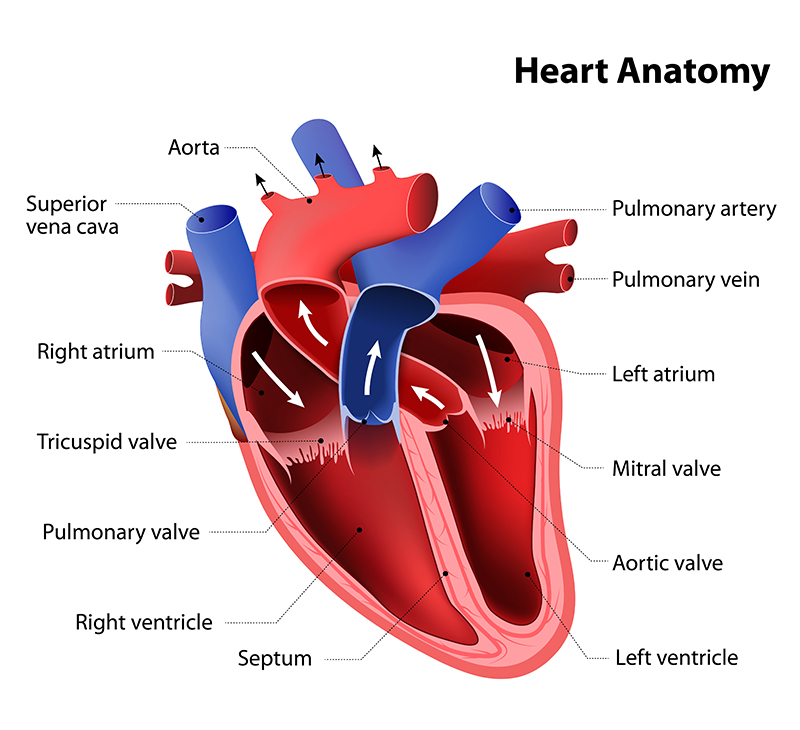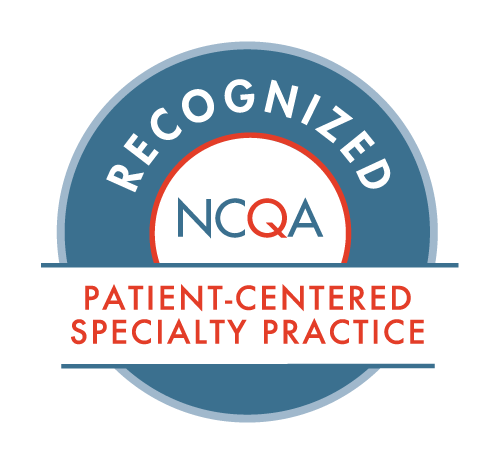Explaining the Cardiovascular System
- Posted on: Mar 3 2021
The cardiovascular system is made up of your heart and circulatory system. The heart is a pump for blood, and the circulatory system is a network of pathways for the blood to travel throughout the body and back to the heart.
How Does the Heart Work?
Your heart is a vital muscular organ that continuously pumps blood to your body’s other organs, tissues and cells, providing them with oxygen and nutrients needed to function. The blood is then returned to the heart where carbon dioxide and waste products from the cells are removed.
Vital organs are those essential for life.
If a vital organ is injured beyond repair or stops working, the body will not survive.
The Heart: Anatomy and Function
Your heart has four chambers: two upper chambers called the atria (left atrium and right atrium) and two bottom chambers called the left and right ventricles. The flow of blood passes in the following order through all four chambers:

The right atrium receives oxygen-depleted blood returning through the veins and pumps it down to the right ventricle.
↓
The right ventricle then pumps this blood to your lungs, which fill the blood with oxygen and send it back to the left atrium.
↓
The left atrium receives this oxygenated blood from the lungs and pumps it down to the left ventricle.
↓
The left ventricle, which is the strongest chamber of the heart, pumps the now oxygen-rich blood to the rest of the body. The left ventricle contracts so hard that it creates our blood pressure.
The rest of the heart anatomy includes:
- The pericardium is a protective sac surrounding the heart and keeping it in the proper place inside your chest.
- Coronary arteries around the outside surface of the heart provide oxygen-rich blood to the heart muscle.
- Nerves also run throughout the heart. These nerves are responsible for telling the heart when to contract (squeeze) and when to relax (release).
The Circulatory System: Anatomy and Function
Blood travels throughout your entire body via blood vessels and then returns to the heart to be cleaned and pumped back out again. Blood is carried away from your heart to your body through blood vessels called arteries, arterioles and capillaries. Blood returns to your heart through blood vessels called venules and veins.
- The process of blood flowing throughout your body is called circulation.
- Arteries carry oxygen-rich blood away from your heart:
-
- There are 20 major arteries.
- Arteries branch out into arterioles, which are smaller blood vessels.
- Arterioles branch out into capillaries, which are the vessels that actually deliver blood to your organs and cells. Most are thinner than a human hair.
-
- Veins carry blood depleted of oxygen back to your heart:
- After delivering oxygen and nutrients, the capillaries take the carbon dioxide and other waste products of cells and move the blood to larger vessels called venules.
- Venules join up to form even larger veins, which deliver the blood back to the heart to pick up oxygen and repeat the continuous process.
Common Medical Problems of the Cardiovascular System
Because the cardiovascular system is vital and so complex, it is susceptible to various medical conditions, some that can be serious enough to cause death. The most common cardiovascular problems include:
- Coronary artery disease is the most common cardiovascular disease in the United States. Less blood flows through the heart, which can cause a heart attack.
- Angina is a symptom of coronary artery disease with chest pain or discomfort that occurs when the heart is not getting enough blood.
- Heart attack, also called myocardial infarction, occurs when the blood flow to the heart is blocked, usually from plaque buildup in the arteries. Plaque can rupture and form a clot that blocks blood flow, damaging or destroying part of the heart muscle. Heart attacks can cause death if not immediately treated.
- Acute coronary syndrome includes heart attack and unstable angina.
- Arrhythmias are irregular or unusually fast or slow heartbeats. There are many types of arrhythmias, some which can cause stroke and death.
- Atherosclerosis is when cholesterol deposits called plaque accumulate in the arteries that supply blood to the heart, causing arteries to narrow over time.
- Cardiomyopathy is a condition where heart muscle becomes enlarged or stiff, which leads to weakened heart pumping and other problems.
- Heart failure, also called congestive heart failure, occurs when fluid builds up in the lungs, liver, legs, and feet because the heart can’t pump enough blood to meet the body’s needs. Though referred to as “failure,” the heart does not stop, but is just too weak to pump the proper amount of blood.
- Peripheral arterial disease (PAD) occurs when the arteries that supply blood to the arms and legs (the periphery, or outside) become narrow or stiff, usually resulting from atherosclerosis. Blood flow and oxygen to the arms and legs is too low or blocked completely.
- Pulmonary hypertension is blood pressure that is too high in the arteries leading from the heart to the lungs.
- Valvular heart disease occurs when diseased valves in the heart do not properly open and close, causing the heart to work harder and ineffectively pump blood.
- Sudden cardiac arrest is a sudden stop of heart function, breathing and consciousness, usually occurring due to a problem with the heart’s electrical system. Sudden cardiac arrest is not the same thing as a heart attack, though a heart attack can sometimes cause an electrical disturbance that leads to sudden cardiac arrest.
Diagnosing Problems with the Cardiovascular System
Heart conditions and diseases require a specially trained doctor called a cardiologist. Cardiology is a branch of medicine that specializes in diagnosing and treating diseases of the heart, blood vessels, and circulatory system.
What is a Cardiologist?
Cardiologists are doctors specializing in the treatment of the cardiovascular system. After completing medical school, they undergo special education and training in the diseases, conditions and abnormalities of the heart and cardiovascular system. They are qualified to treat the diseases and disorders listed above, as well as congenital (birth) abnormalities.
Besides performing diagnostic tests, surgeries and implants, they may also prescribe medications and recommend heart healthy lifestyle changes such as diet, exercise, reducing stress levels and managing weight.
Diagnostic Testing
If you have been referred to a cardiologist, your doctor will most likely need to do diagnostic testing to determine your diagnosis. These tests include:
- A physical exam
- Blood tests
- Stress tests (also known as exercise stress tests)
- Imaging tests, such as computed tomography (CT) and magnetic resonance imaging (MRI), chest X-ray, cardiac angiogram (x-ray with dye injected into the veins)
- An electrocardiogram (EKG or ECG)
- An echocardiogram (echo)
- Ambulatory (walking) tests, such as wearable devices like a Holter monitor that can be worn while going about your daily activities
- Implantable device tests used to gain additional information not available by outside wearable devices
How Often Should You See a Cardiologist?
If you have been diagnosed with a heart condition, disease or genetic defect, you’ll need regular monitoring by your cardiologist. How often depends entirely on your specific condition and its treatment, medications you are taking, if regular testing is needed, and if you are recovering from a surgery.
The cardiologists at Hunterdon Cardiovascular Associates are here to help you from diagnosis through treatment and ongoing management. We also have specialty centers for certain cardiovascular conditions that require unique care. Your health is our priority. To learn more about the diagnostic services and treatments we offer at Hunterdon Cardiovascular Associates, schedule a consultation by calling (908)-788-1710. Our providers happily serve patients from Flemington, Clinton, Bridgewater, and surrounding areas in New Jersey.
Posted in: Uncategorized



